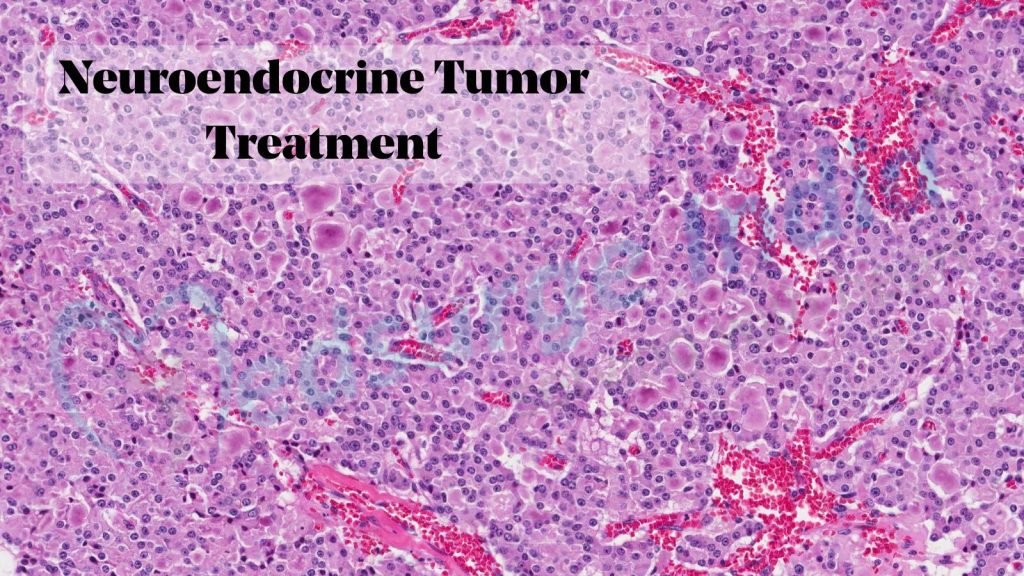
A neuroendocrine tumor is an extremely rare and unique type of cancer. Cancer is a disease in which the body’s cells begin to divide uncontrollably and spread locally and to distant locations. Most cancers start in certain regions of the body, such as the lungs, kidneys, mouth, testes, and ovary.
A neuroendocrine tumor (NET) is a type of tumour that affects the nervous system. NETs develop slowly, and symptoms may not present for several years before the tumour is discovered. Neuroendocrine tumors are most commonly found in the following spots:
- Carcinoid tumors(Lung)
- Pancreatic NETs
- Lung Nuroendocrine Tumor
- Small Intestine Neuroendocrine Tumor
- Large Intestine Neuroendocrine Tumor
- Neuroendocrine Tumor of Liver
- Gastric Neuroendocrine Tumor
Neuroendocrine tumors can be seen in a variety of locations, including the thyroid, adrenals, cervix, vagina, and ovary.
It’s crucial to understand that neuroendocrine cancer of the lungs, stomach, and other organs is different from regular cancer (carcinomas) of these organs.
Neuroendocrine tumours are cancers that can form any place where endocrine cells exist. Endocrine cells assist in the regulation of a variety of bodily functions, including growth, reproduction, and metabolism. They can be found all over the body, although the lungs, small intestines, and pancreas are the most prevalent sites for tumor development.
What is Neuroendocrine System?
The endocrine system is a messenger system that regulates distant target organs through feedback loops of hormones secreted by internal glands of an organism straight into the circulatory system. The hypothalamus is the neurological control centre for all endocrine systems in vertebrates.
Nerve and gland cells make up the neuroendocrine system. It produces hormones and delivers them into the bloodstream, allowing the body to function properly. The words neuro and endocrine refer to the cells that make up the endocrine system. Neuroendocrine cells can be found in a variety of body organs, including the intestine, lung, stomach, and pancreas.
Sign and Symptoms of Neuroendocrine Tumors
Because there is no uniform set of sign and symptoms for neuroendocrine tumors, they might be detected for a variety of causes. A symptom, such as tiredness, nausea, or discomfort, is something that only the person experiencing it can identify and explain. A symptom is something that can be identified and measured by others, such as a fever, rash, or an increased pulse. Signs and symptoms, when combined, can assist describe a medical condition.
The following tumor-related symptoms or signs may be experienced depending on the type of Neuroendocrine tumor:
- Unexplained Weightloss
- Loss of appetite
- Pain in a specific region that doesn’t seem to go away
- A bulge or thickening in any area of the body
- Vomiting or nausea
- Coughing or hoarseness that is persistent
- Changes in the way you eat or how you use the bathroom
- The yellowing of the skin and the whites of the eyes is known as jaundice.
- Bleeding or discharge that is unusual
Symptoms related to release of hormones:
- Ulcer
- Skin Rash
- Diarrhea
- Anxiety
- Hypoglycemia
- Facial Flushing
Neuroendocrine Tumor Treatment Cost in India
The average Neuroendocrine Tumor Treatment Cost in India starts from USD 2,700. India has some of the best specialists who are known to be one of the best in the world and the hospitals have some of the most modern sophisticated equipment and facilities.
Neuroendocrine Tumor Treatment Cost in Different Parts of India
| Cities | Starting Price |
| Delhi | USD 2,700 |
| Gurgaon | USD 2,700 |
| Noida | USD 2,700 |
| Mumbai | USD 2,800 |
| Hyderabad | USD 2,700 |
| Chennai | USD 2,700 |
| Kolkata | USD 2,700 |
| Bangalore | USD 2,800 |
Please keep in mind that prices of Neuroendocrine Tumor Treatment Cost in India will vary depending on the various factors.
Factors That Can Affect Neuroendocrine Tumor Treatment Cost in India
The following here are some variables that can affect Neuroendocrine Tumor Treatment Cost in India:
- Medication costs.
- Duration of treatment.
- Geographical location.
- Hospitalization expenses.
- Government policies and subsidies.
- Medical tourism packages.
- Hospital reputation and infrastructure.
- The expertise and experience of medical professionals.
- The type and frequency of diagnostic procedures.
- The choice of treatment modality.
Even after eliminating the cost of hotel, meals, and transportation, the caliber and grade of medical care and amenities are on par with that of the world’s most renowned healthcare centers. Patients can receive the lowest Neuroendocrine Tumor Treatment Cost in India from Medsurge India.
What Are the Causes of Neuroendocrine Tumor?
Neuroendocrine tumors are unknown in their specific cause. These malignancies start in neuroendocrine cells, which are similar to nerve cells and hormone-producing cells in appearance. Neuroendocrine cells can be found all over the body.
Although the specific causes of Neuroendocrine Tumor are unknown, there are a few factors that raise the chance of malignancy:
- Genes
- Excess use of Tobacco
- Family history
- Weakened Immune System
Neuroendocrine tumor are caused by alterations (mutations) in the DNA of neuroendocrine cells. The instructions that inform a cell what to do are stored in its DNA. The alterations cause the neuroendocrine cells to proliferate and create a tumor.
Some neuroendocrine tumors progress at a glacial pace. Others are malignancies that invade and destroy normal body tissue or spread to other places of the body (metastasize).
Get Free Cost Estimation
Procedure
How Diagnosis of Neuroendocrine Tumor is Done?
The tests and procedures used to diagnose a neuroendocrine tumor are determined by the location of the tumour in your body. In general, tests may involve the following:
- Physical examination
- Imaging Tests
- Ultrasound/ CT Scan
- Test to detect excess of hormones
- Biopsy
If there’s a chance your neuroendocrine tumor has migrated to other parts of your body, you might need more testing to figure out how bad it is.
Treatment for Neuroendocrine Tumor
Treatment for a neuroendocrine tumor (NET) is determined by several factors, including the location of the malignancy, its size, and whether or not it has spread.
NETs grow at various speeds, but they frequently grow slowly. In general, neuroendocrine tumor treatment options might include:
- Surgery
- Chemotherapy
- Targeted Drug Therapy
- Peptide Receptor Radionuclide Therapy (PRRT)
- Medication to control excess hormones
- Radiation Therapy
The extent to which pancreatic neuroendocrine tumors (NETs) can be resected (fully removed) determines how they are treated. However, other factors such as your overall health can have an impact on your treatment options. If you have any questions regarding the treatment plan your doctor advises, talk to him or her.
Pancreatic neuroendocrine tumors are more likely than exocrine pancreas tumors to be resectable. Most NETs can be resected if they haven’t spread to other regions of the body. Even if NETs have propagated, if they have not expanded too far, they may be resectable (such as only to a few spots in the liver).
Other treatment options may be available to you, depending on your situation and the type of neuroendocrine tumour you have.
Several factors influence the recommendations and treatment options, including:
- Neuroendocrine Tumors: Their Causes and Types
- Cancer’s severity
- If it’s malignant, what stage is it at?
- Where has cancer taken hold?
- Other medical issues you may be dealing with
- The patient’s preferences as well as his or her general health
- Whether or if the tumor is functioning
- Possible Negative Consequences
Contact our healthcare experts for the greatest help in making the best selections for your neuroendocrine tumour grade 1 therapy.
Suggestion
A neuroendocrine tumour diagnosis can be distressing and overwhelming. With practise, you’ll be able to cope with the anxiety and distress. If you’re concerned about any signs or symptoms, make an appointment with your doctor. Your doctor may recommend you to a specialist depending on your situation.
It’s a good idea to be well prepared because sessions can be brief and there’s typically a lot of information to go over.
The Most Important Frequently Asked Questions
Q: Do Neuroendocrine Tumors Have to Be Removed?
A: Surgery is the only therapeutic option for some NETs. Your surgeon may still perform surgery to remove the majority of the tumour if the NET has migrated to other places of the body. This is referred to as debulking. Debulking surgery can help you manage your symptoms and feel better, but it will not cure your NET.
Q: What Is the Difference Between Adenocarcinoma and Neuroendocrine?
A: While both pancreatic neuroendocrine tumours and adenocarcinoma originate in the pancreas, their prognoses are substantially different. Unfortunately, adenocarcinomas are far more frequent than neuroendocrine tumors, and they often have a worse prognosis.
Q: How Fast Do Neuroendocrine Tumors Grow?
A: They normally grow slowly over a long period of time, however there are those that grow quickly. There are many different forms of neuroendocrine tumors, but the majority of them fall into one of two categories: Carcinoid tumors are NETs that develop in the gastrointestinal system, lungs, appendix, or thymus.
Q: Can Neuroendocrine Tumors Cause Weight Gain?
A: ACTH (adrenocorticotropic hormone) is a hormone produced by carcinoid tumours that causes the adrenal glands to release too much cortisol (a steroid). Cushing syndrome can result, with symptoms such as weight increase.
Q: Is Neuroendocrine Tumor Grade 1 Malignant?
A: The World Health Organization (WHO) divides neuroendocrine tumors into four categories based on their malignant potential: Neuroendocrine cancers that are well-differentiated (grade 1 and 2) Neuroendocrine tumors with poor differentiation (grade 3).
Top Hospitals for Neuroendocrine Tumor Treatment in India
Top Doctors for Oncology and Oncosurgery
Dr. Koushik Chatterjee
Senior Consultant
Experience: 23+ years of experience
Narayana Superspeciality Hospital, Shibpur, Howrah
Howrah, India
Dr. Arun Kumar Giri
Consultant
Experience: 19 years of experience
Venkateshwar Hospital, New Delhi
New Delhi, India
Dr. Sandeep Mehta
Director
Experience: 22 years of experience
BLK Super Speciality Hospital, New Delhi
New Delhi, India
Dr. Chandra C.K. Naidu
Senior Consultant
Experience: 20 years of experience
Basavatarakam Indo American Cancer Hospital & Research Institute, Hyderabad
Hyderabad, India
Dr. Vineet Gupta
Senior Resident
Experience: 11 years of experience
Primus Super Speciality Hospital, New Delhi
New Delhi, India
Dr. Amit Verma
Senior Consultant
Experience: 16 years of experience
Max Super Specialty Hospital Gurgaon
Gurgaon, India
Dr. Anil Kumar Anand
Director , MBBS, MD
Experience: 22 years of experience
Fortis Memorial Research Institute
Gurgaon, India
Dr. Jose Easow
Consultant
Experience: 25 years of experience
Apollo Cancer Hospital, Chennai
Chennai, India
Dr. Muzammil Shaikh
MBBS, MD - General Medicine, DNB - Medical Oncology, DM - Oncology
Experience: 20 years of experience
Nanavati Super Specialty Hospital, Mumbai
Mumbai, India
Dr. Praveen K. Dadireddy
Consultant , MBBS
Experience: 18 years of experience
Continental Hospitals, Hyderabad
Hyderabad, India
Dr. Ayan Basu
Senior Consultant
Experience: 14 years of experience
HCG EKO Cancer Centre, Kolkata
Kolkata, India














































